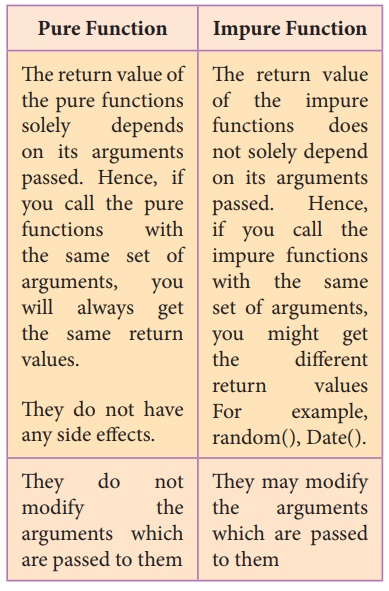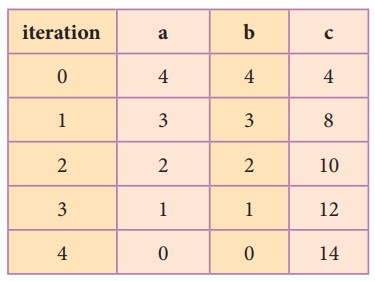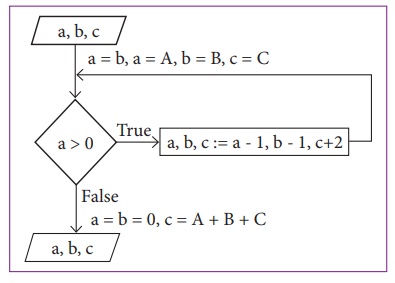Computer Science - Pure functions | 12th Computer Science : Chapter 1 : Problem Solving Techniques : Function
Chapter: 12th Computer Science : Chapter 1 : Problem Solving Techniques : Function
Pure functions
Pure functions
Pure functions are functions which will give
exact result when the same arguments are passed. For example the mathematical function
sin (0) always results 0. This means
that every time you call the function
with the same arguments, you will always get the same result. A function can be
a pure function provided it should not have any external variable which will
alter the behaviour of that variable.
Let us see an example
let square x
return: x * x
The above function square is a pure function
because it will not give different results for same input.
There are various theoretical advantages of
having pure functions. One advantage is that if a function is pure, then if it
is called several times with the same arguments, the compiler only needs to
actually call the function once. Lt’s see an example
let i: = 0;
if i <strlen (s) then
--Do something which doesn't affect
s
++i
If it is compiled, strlen (s) is called each
time and strlen needs to iterate over the whole of ‘s’. If the compiler is
smart enough to work out that strlen is a pure function and that ‘s’
is not updated in the loop, then it can remove the redundant extra calls to
strlen and make the loop to execute only one time. From these what we can
understand, strlen is a pure function because the function takes one variable
as a parameter, and accesses it to find its length. This function reads
external memory but does not change it, and the value returned derives from the
external memory accessed.
1. Impure functions
The variables used inside the function may
cause side effects though the functions which are not passed with any
arguments. In such cases the function is called impure function. When a
function depends on variables or functions outside of its definition block, you
can never be sure that the function will behave the same every time it’s called.
For example the mathematical function random() will give different outputs for
the same function call.
let Random number
let a := random()
if a > 10 then
return: a
else
return: 10
Here the function Random is impure as it is not
sure what will be the result when we call the function.
2. Side-effects (Impure functions)
As you are aware function has side effects when
it has observable interaction with the outside world. There are situations our
functions can become impure though our goal is to make our functions pure. Just
to clarify remember that side effect is not a necessary bad thing.Sometimes
they are useful (especially outside
functional programming paradigm).
Modify variable outside a function
One of the most popular groups of side effects
is modifying the variable outside of function.
For example
let y: = 0
(int) inc (int) x
y= y + x;
return (y)
In the above example the value of y get changed
inside the function definition due to which the result will change each time.
The side effect of the inc () function is it is changing the data of the
external visible variable ‘y’. As you can see some side
effects are quite easy to spot and some of them may tricky. A good sign that
our function impure (has side effect) is
that it doesn’t take any arguments
and it doesn’t return any value.
From all these examples and definitions what we
can understand about the main differences between pure and impure functions are

Now let’s see the example of a pure function to
determine the greatest common divisor (gcd)
of two positive integer numbers.
let rec gcd a b :=
if b <> 0 then gcd b (a mod
b) else return a;;
output
gcd 13 27;;
- : int = 1
gcd 20536 7826;;
- : int = 2
In the above example program ‘gcd’ is the name of the function which
recursively called till the variable ‘b’
becomes ‘0’. Remember b and (a mod b) are two arguments passed to ‘a’ and ‘b’ of the gcd
function.
Chameleons of Chromeland problem using function
Recall the In the Chameleons of Chromeland
problem what you have studied in class XI. suppose two types of chameleons are
equal in number. Construct an algorithm that arranges meetings between these
two types so that they change their color to the third type. In the end, all
should display the same color.
Let us represent the number of chameleons of
each type by variables a, b and c, and their initial values by A, B and C, respectively. Let a = b be the input property.
The input – output relation is a = b = 0 and c
= A + B + C. Let us name the algorithm monochromatize. The algorithm can be
specified as
monochromatize (a, b, c)

In each iterative step, two chameleons of the
two types (equal in number) meet and
change their colors to the third one. For example, if A, B, C = 4, 4, 6, then
the series of meeting will result in

In each meeting, a and b
each decreases by 1, and c increases by 2. The solution can be
expressed as an iterative algorithm.
monochromatize (a, b, c)
--inputs : a = A, b=B, c=C, a=b
--outputs : a = b = 0, c = A+B+C
while a>0
a, b, c := a-1, b-1, c+2
The algorithm is depicted in the flowchart as
below

Now let us write this algorithm using function
let rec monochromatize a b c :=
if a > 0 then
a, b, c := a-1, b-1, c+2
else
a:=0, b:=0, c:= a + b + c
return c
Related Topics